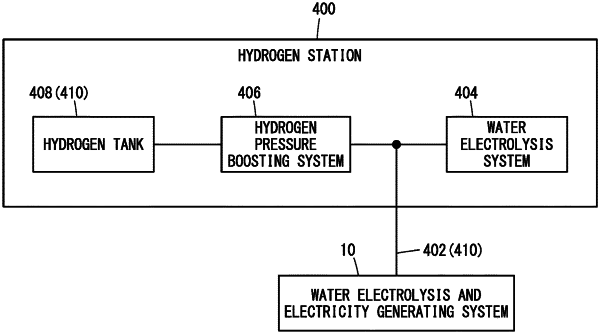| CPC H01M 8/043 (2016.02) [C25B 1/04 (2013.01); C25B 9/19 (2021.01); C25B 15/02 (2013.01); C25B 15/083 (2021.01); H01M 8/04097 (2013.01); H01M 8/04171 (2013.01); H01M 8/04201 (2013.01); H01M 8/04388 (2013.01); H01M 8/04761 (2013.01); H01M 8/1004 (2013.01); H01M 16/003 (2013.01)] | 3 Claims |

|
1. A water electrolysis and electricity generating system comprising a cell member having a membrane electrode assembly in which an electrolyte membrane is sandwiched between a first electrode and a second electrode, a first fluid flow path configured to supply water and an oxygen-containing gas to the first electrode, and a second fluid flow path configured to supply hydrogen gas to the second electrode;
wherein the water electrolysis and electricity generating system is capable of being switched between a water electrolysis mode, in which the water supplied to the first electrode is electrolyzed to thereby generate product hydrogen gas at the second electrode, and an electricity generating mode, in which electricity is generated by an electrochemical reaction that takes place between the oxygen-containing gas supplied to the first electrode and the hydrogen gas supplied to the second electrode;
the water electrolysis and electricity generating system further comprising:
a supply flow path configured to supply the hydrogen gas to the second fluid flow path;
a lead-out flow path through which the product hydrogen gas is led out from the second fluid flow path at a time of the water electrolysis mode, and through which a hydrogen exhaust gas is led out from the second fluid flow path at a time of the electricity generating mode;
a gas-liquid separator configured to separate into a gas and a liquid the product hydrogen gas and the hydrogen exhaust gas that are led out from the lead-out flow path;
a circulation flow path configured to guide the hydrogen exhaust gas, which has been separated into a gas and a liquid by the gas-liquid separator, to the supply flow path; and
a storage flow path configured to guide the product hydrogen gas, which has been separated into a gas and a liquid by the gas-liquid separator, to a hydrogen storage unit;
an intermediate lead-out flow path from which the product hydrogen gas and the hydrogen exhaust gas that have flowed through the gas-liquid separator are led out;
a dehumidifying flow path configured to dehumidify the product hydrogen gas that flows through the intermediate lead-out flow path, and guide the product hydrogen gas to the storage flow path; and
a flow path switching valve configured to be capable of switching between a state in which, at the time of the water electrolysis mode, flow of the hydrogen exhaust gas from the intermediate lead-out flow path to the circulation flow path is permitted, together with blocking flow of the hydrogen exhaust gas from the intermediate lead-out flow path to the dehumidifying flow path, and a state in which, at the time of the electricity generating mode, flow of the product hydrogen gas from the intermediate lead-out flow path to the dehumidifying flow path is permitted, together with blocking flow of the product hydrogen gas from the intermediate lead-out flow path to the circulation flow path, wherein the lead-out flow path and the gas-liquid separator are shared in common by the water electrolysis mode and the electricity generating mode.
|